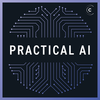Lessons from 10k hours of programming (remastered)
This week we’re going back in time to one of our top performing shows of all time where we talk with Matt Rickard about his blog post Reflections on 10,000 Hours of Programming. These reflections are about deliberately writing code for 10,000 hours. Most don’t apply to beginners. He was clear to mention that these reflections are purely about coding, not career advice or soft skills. If you count the reflections we cover on the show and be the first to comment the amount of reflections on this thread in Zulip, we’ll give you a coupon code to use for a 100% free t-shirt from the merch store. Good luck…





